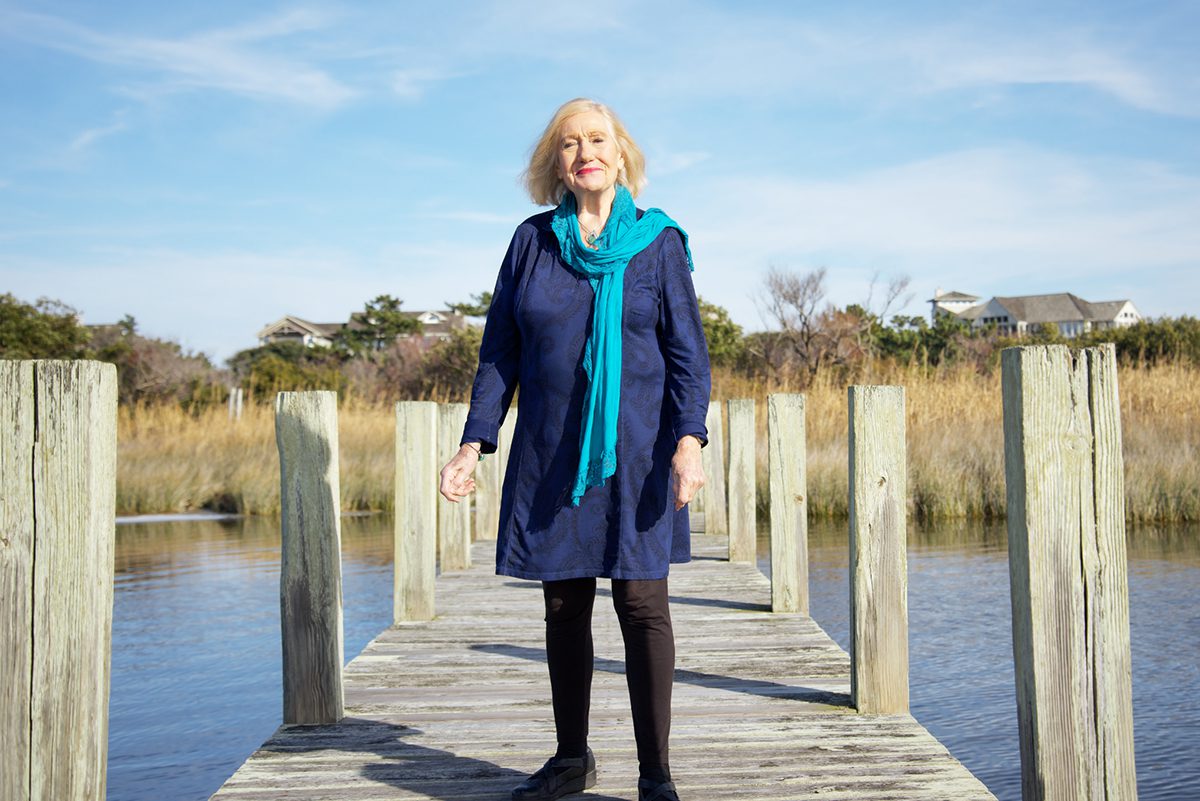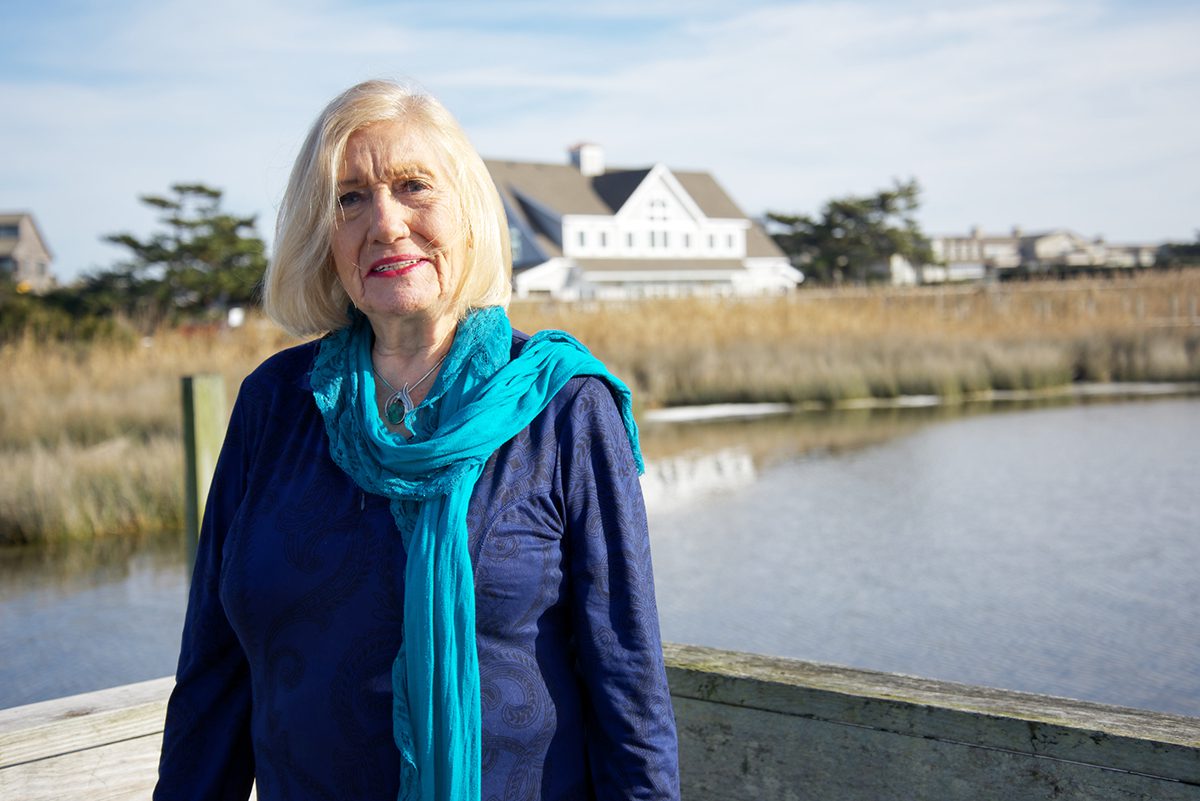
In the early 1970s, the Outer Banks were still rough enough around the edges that it was possible to confuse the rolling sand dunes and pounding surf with the rugged coast of England. At least, that is what Lilias J. Morrison thought the first time she saw Nags Head.
It was sometime around 1970, she thinks. She was cruising along the interstate in a turquoise VW Bug with her good friend, Jennifer Frost. They were on holiday, heading back to New York City, where they were graduate students at Columbia University. It was 4 or 5 in the afternoon. The sun was sinking. Rounding a bend in the road, a sign for the then-modest resort appeared. “It sounded like a place back home in England,” Morrison recalled. “I said to Jennifer, ‘Let’s go see.’”
Supporter Spotlight
Morrison had grown up in Lancashire, on the edge of the Lake district of the United Kingdom, earned degrees in theology at Sheffield and Oxford, then spent three years teaching Latin at a girl’s high school in Nairobi, before moving to the United States to continue studies for her doctorate.
She never collected the advanced degree.
The Outer Banks got in the way.
~
Most of the visitors who crowd onto the Outer Banks probably have never heard of Lilias Morrison, let alone know her remarkable backstory: A theology student who became one of the Outer Banks’s most influential designers — not to mention, the first woman builder of consequence along the Northern Banks. Like one of her mentors, the late Earl Slick, she is proud yet quiet, comfortable yet humble. But don’t ever confuse her with lacking ambition. Morrison helped to design and market Sanderling and Palmer’s Island, two of the more admired developments north of Duck. She later formed her own company, Real Escapes, focusing on environmentally friendly and energy efficient builds, remodels, and sales – or as she likes to say, “houses that blend into the land” instead of overwhelming it. Along the way, there were forays into local politics, a campaign to protect the quaint, village-like nature of Duck, even a drive to fend off big-box stores and keep the skies dark.
Supporter Spotlight
Morrison, who describes herself as “over 75” and still has a pleasing lilt in her voice, never wanted to be an ordinary developer. “I became a builder because local builders wouldn’t do anything except beach boxes,” she said “We didn’t want to turn the oceanfront into suburbia by the sea. We placed a great emphasis on preservation and conservation.”

Which isn’t surprising when you learn a bit about Morrison’s past. Growing up in the Lake District in Northwest England, she was surrounded by botanical gardens and historic buildings. “I grew up with these wonderful landscapes. There were living gardens. Land for parks and museums. In the old industrial steel towns, historic factory buildings with abstract strength I admired. All of this had a great influence, you see.”
Morrison had always wanted to travel in Africa and after university got her chance. With a family friend’s help, she landed a job teaching at The Kenya High School for Girls, one of the best schools in the British Commonwealth. “My job other than teaching some biblical stuff to train people to think, I taught Greek and Latin as well. It was high academics with a goal of getting the girls to take the Oxford and Cambridge entrance exams.”
During breaks, Morrison and the other young teachers explored the continent, visiting wildlife parks and climbing Mount Kilimanjaro. One of her favorite places was Kampala, the capital of Uganda. “Those days, Kampala was the Athens of Africa, (home to) writers and artists,” she said.
In the mid-1960s, Morrison moved to the United States to continue graduate studies in theology at Union Theological Seminary, affiliated with Columbia University. She landed there amid wrenching cultural shifts and student protests. “We were rebels,” she laughed. “I remember climbing a gate.”
She met Jennifer Frost at Columbia, an older student from Rhodesia, now Zimbabwe, who liked to travel and surf. They planned adventures, moved to Germany to learn the language, drove to Atlanta, and then tumbled into Nags Head, where they fell in love with the locals and the coast. “We didn’t have much time. We spent the days walking the beach, swimming, walking the upper ridge of Jockey’s Ridge, which was bigger in those days. We both said we would come back to this wonderful place,” Morrison said. And they did.
They returned the following fall. Then again that spring. The owners of a Nags Head bakery invited them for drinks, recalling how they had moved to the Banks from the Midwest. The idea for a bakery evolved slowly but once it did, it stuck. They opened on Memorial Day and closed on Labor Day, and made just enough to get through their first winter and reopen the following spring. Lilias and Jennifer were enthralled and decided they should do a business, too. But what kind of business? And where?
They wound up in Manteo where they discovered the history of “The Lost Colony” and met a helpful real estate agent named Phil Quidley. They had no money, they explained, but wanted to start a small business. Somehow, Quidley negotiated a modest down payment and they became the owners of the Fort Raleigh Hotel. During season they could count on overnight guests coming to see “The Lost Colony.” They also became agents for Western Union. Lilias used her botanical skills to turn a garden into a local attraction, naming it for Sir Richard Granville, the daring naval commander from Cornwall.
Lilias and Jennifer ran the hotel for two seasons. Like many Bankers they scrambled in the off-season, working as waitresses at the Sea Ranch Motel and studying in their spare time for their real estate licenses. “We weren’t too proud to be waitresses. Our main financial goal was survival, you see,” said Morrison.
By now, it was the mid-1970s. Lilias and Jennifer began to sell houses and lots in Hatteras, Nags Head, and Collington. They eventually found their way north, to the Village of Duck, which wasn’t much more than a few dozen houses, a surf shop, post office, and a grocery store. Still, they saw the potential and wanted a piece of the action.
One day, Jennifer saw an advertisement for a project called Sanderling and, on a hunch, phoned. She soon found herself speaking with John C. Whitaker Jr., a talented young builder with a vision for a quaint, natural community built in the old Nags Head style – no tennis courts, no swimming pools, but lots of nature trails and unpretentious houses meant to be passed from generation to generation.
In 1977, Lilias and Jennifer began working for Whitaker as sales agents and landscape designers. Morrison gives credit to Whitaker for creating one of the more unique resort communities on the Northern Banks. But without Lilias and Jennifer, their boundless energy and creativity, Sanderling may never have thrived. “They turned out to be super salespeople,” said William E. Hollan Jr., who continued developing Sanderling after Whitaker and his partners stepped away in the early 1980s. “I give them 100% of the credit for carrying through on the mission.”
Hollan and Earl Slick, the owner of the property, finished six additional sections of Sanderling and then built the Sanderling Inn. Jennifer left to start a radio station in Duck and take up other real estate ventures. Lilias continued to work closely with Hollan and Slick at Sanderling. Later, when Hollan acquired a small tract of land just north of the Dare County border, Morrison joined him in developing the exclusive gated community known as Palmer’s Island. There was only enough room for a dozen houses – but what houses! They were outsized, New England-style beach homes, with spectacular views of the ocean and the sound.
“It was zoned for multifamily and could have been condominiums. It would have changed the whole character and Sanderling. And so, we decided to build large summer homes rather like Newport for extended families,” Morrison said. “In a way, Sanderling and Palmer’s Island was more old money and old beach atmosphere. Pine Island was more new money: fortunes from the computer industry and Wall Street. Owners who wanted the latest thing. The character of those houses changed.”
At Palmer’s Island, Morrison designed a house for an executive of General Motors. Another house sold to heirs of the DuPont fortune. “Their goal was to be very peaceful and incognito. They were very cautious of their privacy,” Morrison said.
Around 1993, Morrison moved out of Sanderling and set up a new business, the Real Escapes Group, in a historic building in the center of Duck. Her focus shifted from building to designing and remodeling, with a strong focus on preservation and conservation. Today, she runs her business out of a commercial outlet in Harbinger but lives near the sound in Southern Shores in a house she purchased from David Stick, the late historian, politician, and developer.
Related: Frank Stick: A Maverick Who Helped Shape the Outer Banks
She owns other property but doesn’t think she will develop it. “Let’s face it,” she said, “if you are in real estate … you are interested in acquiring property the way (other) people acquire a good overcoat or a pair of shoes.”
Morrison has now lived on the Outer Banks for a half-century. During that time, she has witnessed incalculable changes yet hasn’t lost the sense of surprise or awe she felt that late afternoon she landed in Nags Head years ago. “As far as I am concerned, the Outer Banks are world class,” she said. “There is still a pristine quality I hope will remain in spite of development.”







